Wakeful Watchers
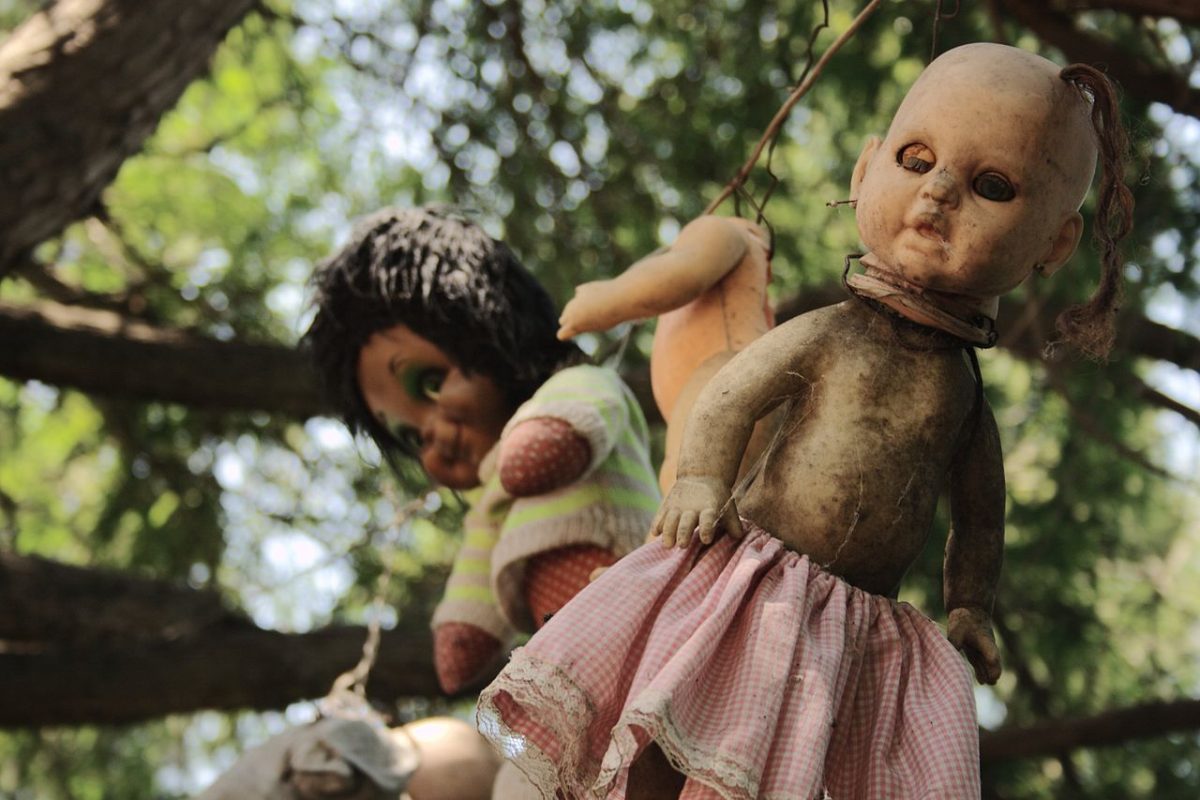
Mexico’s Isla de las Muñecas is a floating garden festooned with dolls — the story goes that a local man discovered a drowned girl, hung her doll from a tree as a gesture of remembrance, and was haunted by her spirit ever after, no matter how many dolls he hung. Today, inevitably, it’s a tourist attraction, but it’s still effective — photographer Cindy Vasko called it the creepiest place she’s ever visited.
Below: As her village has dwindled from 300 residents to 30, Japanese artist Ayano Tsukimi has been replacing them with dolls, life-sized figures made of cloth and stuffed with cotton and newspapers. The first was intended to be a scarecrow, but because it resembled her father she found that her neighbors interacted with it. In the ensuing 10 years she’s made hundreds.
“Every morning, I just greet them,” she told NPR. “I say ‘good morning’ or ‘have a nice day!’ I never get a response, but that doesn’t make a difference. I go around talking to them anyway.”
Mix and Match

The sum of any two of these numbers is a perfect square:
7442 + 28658 = 1902
7442 + 148583 = 3952
7442 + 177458 = 4302
7442 + 763442 = 8782
28658 + 148583 = 4212
28658 + 177458 = 4542
28658 + 763442 = 8902
148583 + 177458 = 5712
148583 + 763442 = 9552
177458 + 763442 = 9702
Two other such sets:
{-15863902, 17798783, 21126338, 49064546, 82221218, 447422978}
{30823058, 63849842, 150187058, 352514183, 1727301842}
Whether there’s a set of six positive integers with this property is an open question.
(A.R. Thatcher, “Five Integers Which Sum in Pairs to Squares,” Mathematical Gazette 62:419 [March 1978], 25-29.)
Wit and Sense
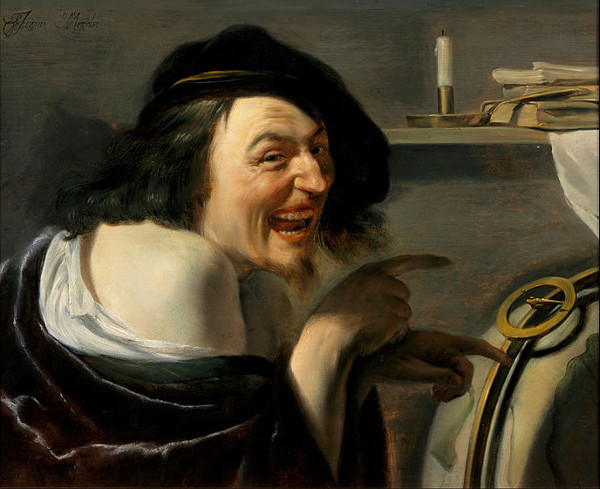
There is an association in men’s minds between dullness and wisdom, amusement and folly, which has a very powerful influence in decision upon character, and is not overcome without considerable difficulty. The reason is that the outward signs of a dull man and a wise man are the same, and so are the outward signs of a frivolous man and a witty man; and we are not to expect that the majority will be disposed to look to much more than the outward sign. I believe the fact to be that wit is very seldom the only eminent quality in the mind of any man; it is commonly accompanied by many other talents of every description, and ought to be considered as a strong evidence of a fertile and superior understanding.
— Sydney Smith, quoted in The Ladies’ Repository, September 1858
A Tree to Climb
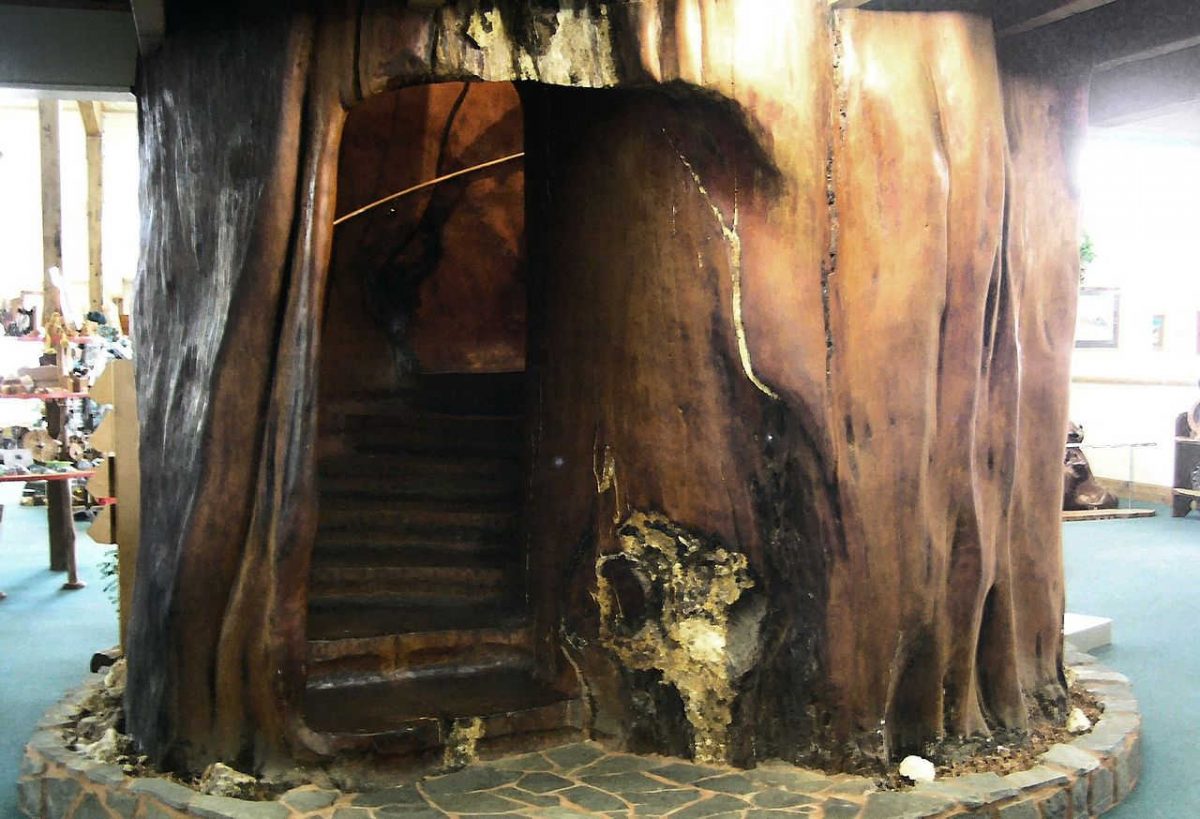
This enormous kauri tree towered for a thousand years over prehistoric New Zealand before it fell into a swamp, where the lack of oxygen and fungus preserved it for 45,000 years. Workers snapped two 90-ton-capacity winch cables trying to extract it in October 1994; finally they cut it into two sections of 110 and 30 tons and hauled them out separately.
Then David Stewart built a concrete pad 20 inches thick, placed a 50-ton section of log atop it, and spent 300 hours carving it with a chainsaw and 200 hours finishing it. At 12 feet in diameter and 17 feet tall, the result is the world’s largest (and certainly oldest) single-piece circular stairway … built inside the log.
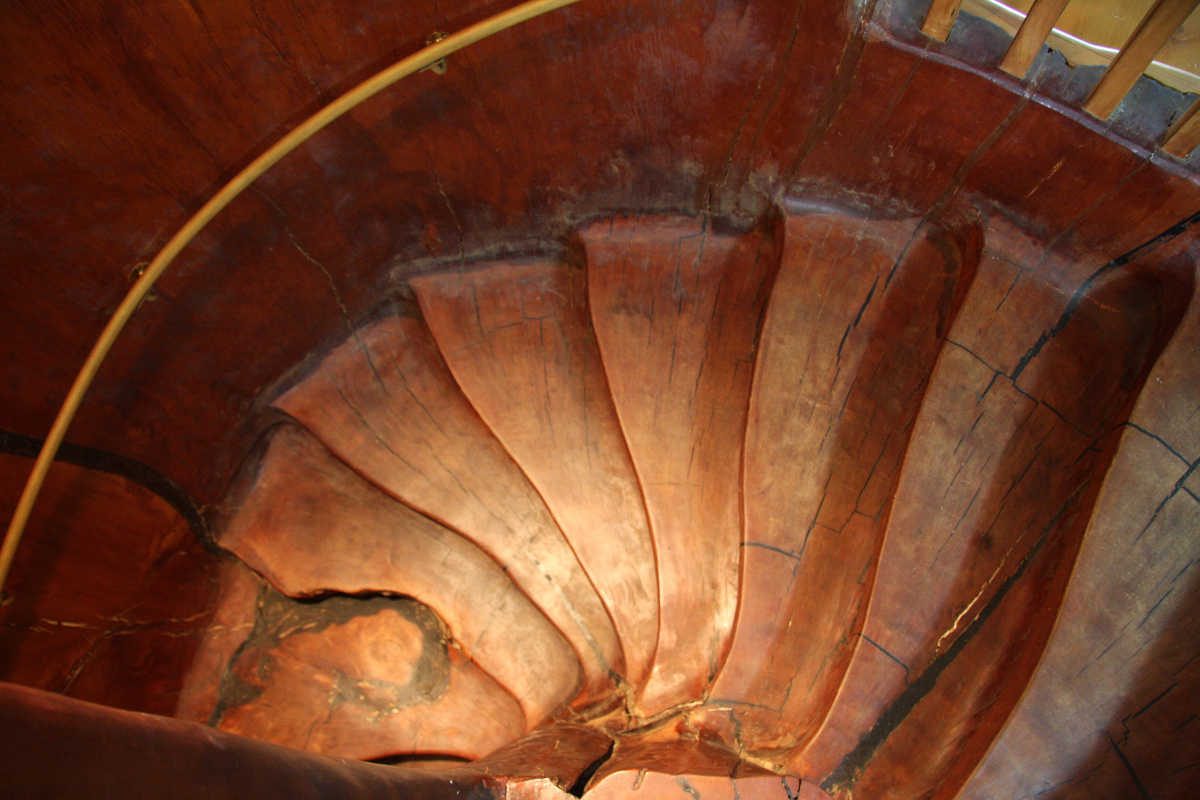
(From Spike Carlsen, A Splintered History of Wood, 2008.)
In a Word
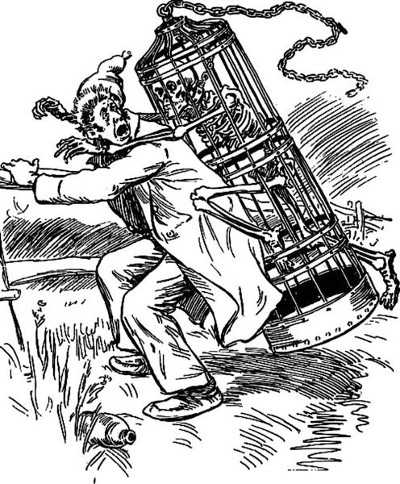
perhorresce
v. to shudder at
Podcast Episode 167: A Manhattan Murder Mystery
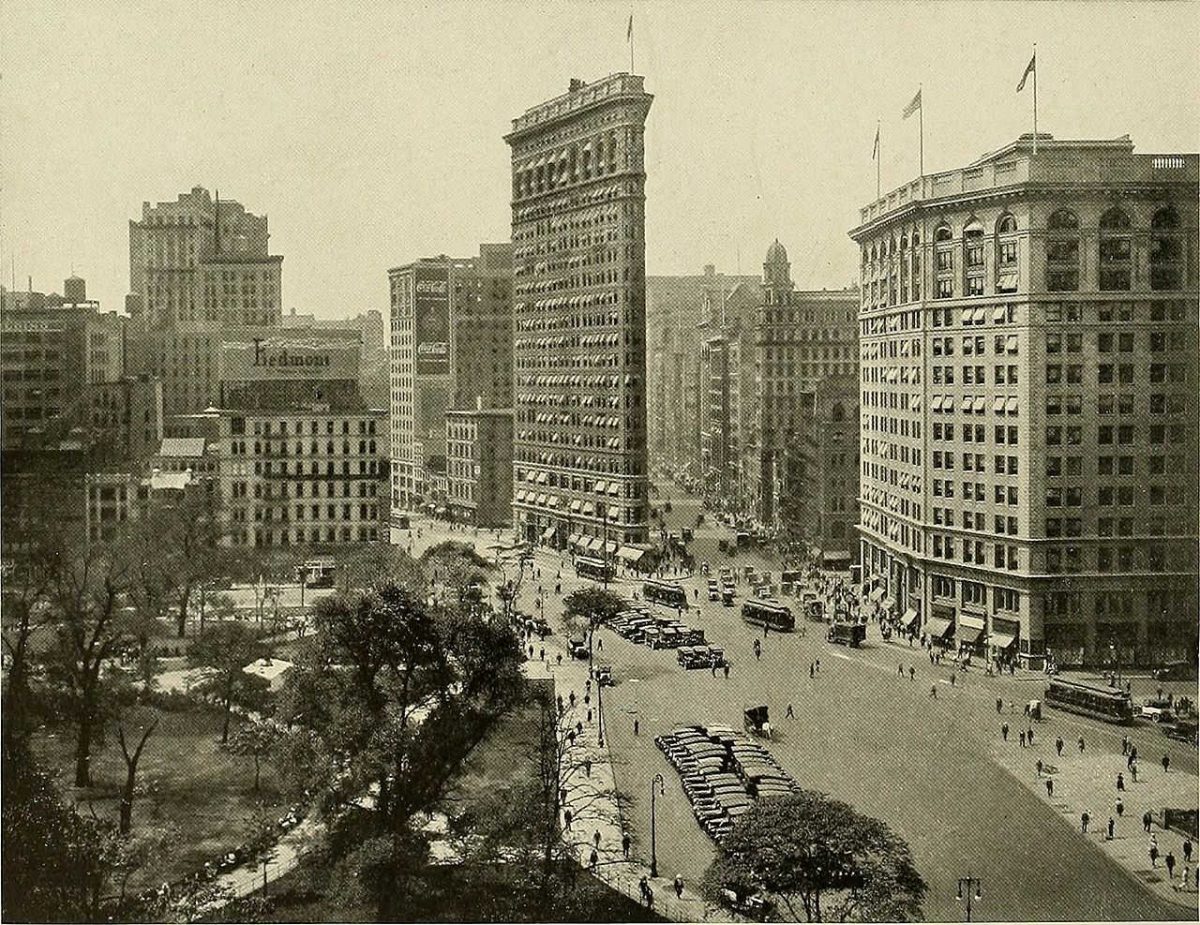
In May 1920, wealthy womanizer Joseph Elwell was found shot to death alone in his locked house in upper Manhattan. The police identified hundreds of people who might have wanted Elwell dead, but they couldn’t quite pin the crime on any of them. In this week’s episode of the Futility Closet podcast we’ll review the sensational murder that the Chicago Tribune called “one of the toughest mysteries of all times.”
We’ll also learn a new use for scuba gear and puzzle over a sympathetic vandal.
Words and Music
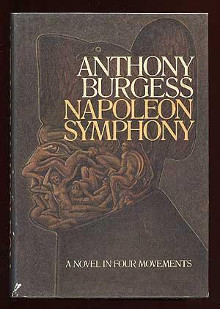
Anthony Burgess based his 1974 novel Napoleon Symphony explicitly on the structure of Beethoven’s Symphony No. 3, the Eroica:
- The story is told in four “movements,” whose length corresponds to the listening time of the corresponding parts of the symphony: 118 pages (14:46 minutes), 120 pages (15:34 minutes), 30 pages (5:33 minutes), and 77 pages (11:27 minutes).
- The allegro takes Bonaparte “from his early Italian triumphs to his crowning as Emperor”; the marcia funebre moves to the retreat from Russia; in the scherzo Napoleon attends a play featuring Prometheus; and the finale depicts his life and death on St. Helena.
- Where the symphony begins with two sharp chords, the novel starts with Napoleon giving Josephine “two excruciating love-pinches.” In the first movement Bonaparte corresponds to the “masculine thematic group,” Josephine to the “second, or feminine subject.” The sonata form requires repetition, so, for example, the opening sentence, “Germinal in the Year Four” appears in the “recapitulation” with a slight variation, as “Germinal in the Year Seven.” The contrasting themes are reflected in shifts of scene and viewpoint, and harmonic variation is suggested by the frequent repetition of certain phrases with minor changes.
- In the second movement Napoleon dreams of his death in verses set precisely to the rhythm of Beethoven’s theme (these are printed with the score in his essay “Bonaparte in E Flat” in This Man and Music):
There he lies,
Ensanguinated tyrant
O bloody, bloody tyrant
See
How the sin within
Doth incarnadine
His skin
From the shin to the chin. - During the retreat from Russia, he approximates counterpoint by writing in two levels of language, which he hopes “will leave an aftertaste of polyphony.” For example: “The primary need, General Eblé said, is to obtain the requisite structural materials and this will certainly entail the demolition of civilian housing in the adjacent township. Now the first job, Sergeant Rebour said, is to get planking, and the only way to get it is to pull down all those fucking houses.”
- In the scherzo the waltz rhythm is reflected in sentences such as “Dance dance dance! The orchestra struck up another waltz” and “They danced. United Kingdom of Benelux Benelux, Britain gets Malte and Cape of Good Hope.”
- The finale is based on the so-called Prometheus theme (E-flat, B-flat, B-flat, E-flat), which Burgess visualizes as a cross in the score. He interprets the initials on Jesus’ cross, INRI, as Impera[torem] Nap[oleonem] Regem Interfec[it], an acrostic that recurs throughout the movement.
Overall, Burgess said, he wanted to pursue “one mad idea”: “to give / Symphonic shape to verbal narrative” and to “impose on life … the abstract patterns of the symphonist.”
He dedicated the novel to Stanley Kubrick, hoping that it might form the basis of the director’s long-planned biography of the emperor, but Kubrick decided that “the [manuscript] is not a work that can help me make a film about the life of Napoleon.” Undismayed, Burgess developed it instead into an experimental novel. The critics didn’t like it, but he said it was “elephantine fun” to write.
(From Theodore Ziolkowski, Music Into Fiction, 2017.)
A Lofty Vision

Brazilian architect Oscar Niemeyer proposed this design for a museum of modern art in Caracas in 1955. He conceived it as a pyramid standing on its apex; the roof would be one vast skylight, and daylight would penetrate the levels inside thanks to spaces at the edges of the floor slabs. There are no side windows so as not to disturb the unity of the slanted walls.
The ground floor would house an auditorium; above that, successively, were a foyer, an exhibition gallery, a mezzanine exhibition space, and the roof, with a sculpture terrace. To free the exhibition halls of load-bearing supports, the mezzanine would be suspended from the four corners of the pyramid by perpendicular tensors.
The whole thing would have perched on a cliff overlooking central Caracas. A change in regime meant that it never got beyond the planning stage.
A Second Look
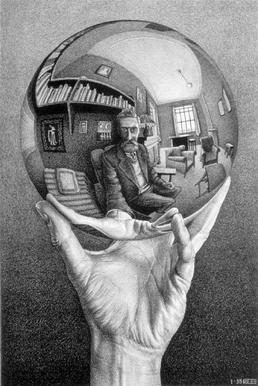
M.C. Escher’s 1935 lithograph Hand With Reflecting Sphere gave artist Kelly M. Houle an idea.
She drew this image in charcoal on a piece of illustration board:
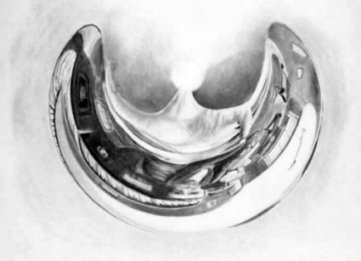
Now when a cylindrical mirror is placed at the center, it produces this reflection:
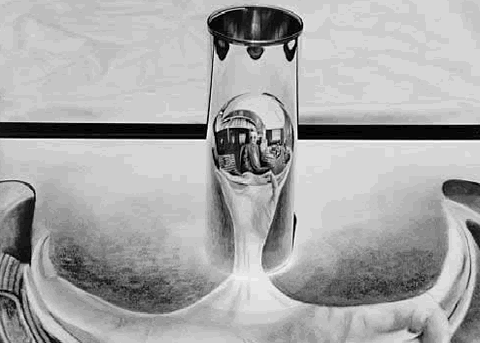
“When the original image is bent and stretched into a circular swath, the shadows seem to fall in all directions,” she wrote. “When the curved mirror is used to reflect the anamorphic distortion, the forms take on the familiar rules of light and shading that make them seem three-dimensional.”
(Kelly M. Houle, “Portrait of Escher: Behind the Mirror,” in D. Schattschneider and M. Emmer, eds., M.C. Escher’s Legacy, 2003.)

